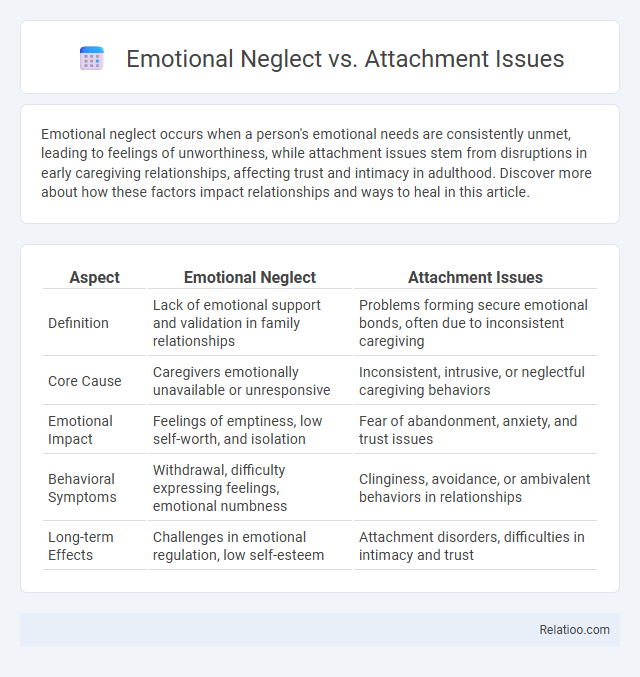Emotional neglect occurs when a person's emotional needs are consistently unmet, leading to feelings of unworthiness, while attachment issues stem from disruptions in early caregiving relationships, affecting trust and intimacy in adulthood. Discover more about how these factors impact relationships and ways to heal in this article.
Table of Comparison
| Aspect | Emotional Neglect | Attachment Issues |
|---|---|---|
| Definition | Lack of emotional support and validation in family relationships | Problems forming secure emotional bonds, often due to inconsistent caregiving |
| Core Cause | Caregivers emotionally unavailable or unresponsive | Inconsistent, intrusive, or neglectful caregiving behaviors |
| Emotional Impact | Feelings of emptiness, low self-worth, and isolation | Fear of abandonment, anxiety, and trust issues |
| Behavioral Symptoms | Withdrawal, difficulty expressing feelings, emotional numbness | Clinginess, avoidance, or ambivalent behaviors in relationships |
| Long-term Effects | Challenges in emotional regulation, low self-esteem | Attachment disorders, difficulties in intimacy and trust |
Understanding Emotional Neglect: Definition and Signs
Emotional neglect involves the consistent failure to respond to a child's emotional needs, leading to feelings of invisibility and unworthiness. Attachment issues, by contrast, arise from disruptions in the caregiver-child bond, affecting your ability to form stable relationships. Recognizing signs of emotional neglect, such as difficulty expressing emotions or chronic feelings of emptiness, is crucial for addressing these overlapping but distinct challenges.
What Are Attachment Issues? Key Concepts Explained
Attachment issues refer to difficulties in forming secure emotional bonds, often stemming from inconsistent or unresponsive caregiving during childhood. These issues can manifest as anxiety, avoidance, or difficulty trusting others, affecting Your ability to build healthy relationships. Understanding attachment theory highlights key concepts such as secure, anxious, avoidant, and disorganized attachment styles, which are essential for recognizing how early experiences shape emotional connections.
Emotional Neglect vs Attachment Issues: Core Differences
Emotional neglect involves a caregiver's consistent failure to respond to a child's emotional needs, leading to feelings of invisibility and unworthiness, while attachment issues stem from disrupted or insecure bonding patterns between a child and caregiver that affect trust and relationship-building. Emotional neglect often results in internalized feelings of emptiness and difficulty recognizing emotions, whereas attachment issues manifest as anxiety, avoidance, or ambivalence in relationships. Understanding these core differences is essential for targeted therapeutic interventions that address either the deficit in emotional responsiveness or the insecurity in relational attachment.
How Childhood Experiences Shape Emotional Health
Childhood experiences play a crucial role in shaping emotional health, with emotional neglect leading to unmet emotional needs and difficulty recognizing or expressing feelings. Attachment issues arise when inconsistent or insecure caregiving disrupts the development of secure emotional bonds, impacting trust and relationship patterns in adulthood. Both emotional neglect and attachment disruptions contribute to challenges in emotional regulation, self-esteem, and interpersonal connections, underlining the long-term impact of early emotional environments on mental well-being.
Common Symptoms of Emotional Neglect
Common symptoms of emotional neglect include difficulty identifying and expressing emotions, feelings of emptiness or numbness, and challenges in forming close, trusting relationships. You may also experience low self-esteem, chronic loneliness, and a persistent sense of being unimportant or unseen. These symptoms often overlap with attachment issues but specifically stem from unmet emotional needs during childhood rather than insecure attachment patterns.
Identifying Attachment Styles in Relationships
Identifying attachment styles in relationships involves recognizing patterns linked to emotional neglect and attachment issues, such as anxious, avoidant, or disorganized attachments. Emotional neglect during childhood often leads to insecure attachment styles, impacting trust, intimacy, and emotional regulation in adult relationships. Differentiating between emotional neglect and attachment issues is crucial for targeted therapeutic interventions that address specific relational dynamics and promote healthy emotional connections.
The Impact of Emotional Neglect on Adult Life
Emotional neglect during childhood can lead to difficulty forming secure attachments in adult relationships, resulting in trust issues and emotional withdrawal. Adults affected by emotional neglect often struggle with low self-esteem and impaired emotional regulation, which can exacerbate attachment insecurities. Addressing emotional neglect through therapy improves emotional awareness and strengthens adult attachment patterns.
How Attachment Issues Manifest in Daily Interactions
Attachment issues manifest in daily interactions through difficulties in forming trusting relationships, frequent emotional withdrawal, and heightened sensitivity to rejection. You may find yourself struggling with inconsistent emotional responses and a persistent fear of abandonment, impacting both personal and professional connections. Recognizing these patterns helps differentiate attachment challenges from emotional neglect, which primarily involves unmet emotional needs during childhood.
Healing Strategies: Addressing Emotional Neglect and Attachment Wounds
Healing strategies for emotional neglect and attachment issues involve cultivating self-awareness and seeking therapeutic support to process unmet emotional needs. Techniques like mindfulness, emotional regulation training, and building secure relationships can repair attachment wounds and foster resilience. Prioritizing Your emotional well-being through consistent self-care and healthy communication strengthens recovery from both emotional neglect and attachment challenges.
Seeking Help: Therapy and Support Resources for Emotional Healing
Therapy plays a crucial role in addressing Emotional Neglect, Attachment Issues, and their overlapping impacts by providing specialized interventions such as cognitive-behavioral therapy and attachment-based therapy tailored to individual needs. Support resources including trauma-informed counseling, support groups, and online platforms enhance emotional healing by offering safe environments for expression and connection. Prioritizing professional help accelerates recovery by fostering self-awareness, building coping mechanisms, and strengthening relational patterns.

Infographic: Emotional Neglect vs Attachment Issues
 relatioo.com
relatioo.com